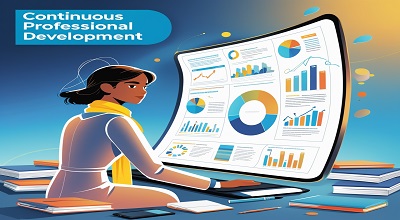Continuous Professional Development
Continuous Professional Development: Continuous Professional Development (CPD) refers to the ongoing process of improving skills, knowledge, and competencies in a professional field. For educators, CPD is essential to stay updated with the latest teaching methodologies, technological advancements, and educational research.
Unlike traditional professional development, which may be sporadic or mandatory, CPD is a proactive, structured, and lifelong learning approach. It ensures that teachers remain effective in their roles, adapt to changing educational landscapes, and provide the best learning experiences for students.
Why is CPD Important for Educators?
Enhances Teaching Quality
CPD helps teachers refine their instructional strategies, classroom management techniques, and assessment methods, leading to improved student outcomes.
Keeps Educators Updated
Education is an evolving field with new research, policies, and technologies emerging regularly. CPD ensures teachers stay informed and relevant.
Boosts Career Advancement
Engaging in CPD opens doors to leadership roles, promotions, and specialized teaching positions.
Encourages Reflective Practice
CPD promotes self-assessment and reflection, helping educators identify strengths and areas for improvement.
Improves Student Engagement and Performance
Well-trained teachers create dynamic and interactive classrooms, fostering better student engagement and academic success.
Latest Trends in CPD for Teachers
Microlearning and Bite-Sized Training
Short, focused learning modules allow teachers to acquire new skills without overwhelming time commitments.
Personalized Professional Development
AI-driven platforms tailor CPD programs based on individual teacher needs and learning styles.
Collaborative Learning Communities
Online forums, PLCs (Professional Learning Communities), and social media groups facilitate peer-to-peer learning.
Gamification in CPD
Badges, leaderboards, and interactive challenges make professional development more engaging.
Hybrid and Blended Learning Models
Combining online courses with in-person workshops provides flexibility and deeper learning experiences.
Effective CPD Strategies for Professional Growth
Setting Clear Goals
Teachers should identify specific skills they want to develop and align them with their career aspirations.
Engaging in Peer Observations and Feedback
Observing colleagues and receiving constructive feedback enhances teaching techniques.
Attending Workshops and Conferences
Industry events provide networking opportunities and exposure to innovative teaching methods.
Enrolling in Online Courses and Certifications
Platforms like Coursera, edX, and LinkedIn Learning offer specialized courses for educators.
Reflective Journaling
Maintaining a teaching journal helps educators track progress and reflect on their experiences.
Technology and Digital Tools for CPD
Learning Management Systems (LMS)
Platforms like Moodle, Google Classroom, and Canvas support structured CPD programs.
Webinars and Virtual Conferences
Teachers can attend global education summits without geographical constraints.
Podcasts and Educational Blogs
Listening to expert discussions and reading industry blogs keeps educators informed.
AI-Powered Coaching Tools
AI-driven platforms provide real-time feedback on teaching practices.
Mobile Learning Apps
Apps like Khan Academy and Duolingo offer bite-sized professional development resources.
Challenges in Implementing CPD and How to Overcome Them
Lack of Time
Solution: Integrate microlearning and flexible online courses.
Limited Funding
Solution: Seek free or low-cost CPD resources like MOOCs and open educational resources (OER).
Resistance to Change
Solution: Foster a culture of lifelong learning through incentives and recognition.
Measuring Effectiveness
Solution: Use feedback surveys, student performance data, and self-assessment tools.
Measuring the Impact of CPD
Student Performance Metrics
Improved test scores and engagement levels indicate successful CPD.
Teacher Self-Assessments
Reflective practices and surveys help evaluate personal growth.
Peer and Administrator Feedback
Constructive evaluations from colleagues and supervisors provide insights.
Institutional Growth
Schools with strong CPD programs often see higher retention rates and better academic outcomes.
Future of Continuous Professional Development
- AI and Machine Learning: Personalized CPD recommendations based on performance data.
- Virtual Reality (VR) Training: Immersive simulations for classroom management and teaching strategies.
- Global Collaboration: Cross-border professional learning networks.
- Lifelong Learning Culture: CPD becoming an integral part of teacher accreditation systems.
Conclusion
Continuous Professional Development is no longer optional but a necessity for educators aiming for excellence. By embracing the latest trends, leveraging technology, and adopting effective strategies, teachers can enhance their skills and positively impact student learning.
Free Download: Royal188Bet APK
